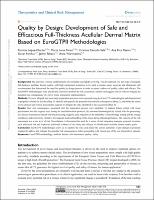| dc.contributor | Vall d'Hebron Barcelona Hospital Campus |
| dc.contributor.author | López-Chicón, Patricia |
| dc.contributor.author | Pérez, Maria Luisa |
| dc.contributor.author | Castells-Sala, Cristina |
| dc.contributor.author | Piteira, Ana Rita |
| dc.contributor.author | Fariñas Barbera, Oscar |
| dc.contributor.author | Tabera, Jaime |
| dc.contributor.author | Vilarrodona, Anna |
| dc.date.accessioned | 2023-08-22T12:28:48Z |
| dc.date.available | 2023-08-22T12:28:48Z |
| dc.date.issued | 2023-07-04 |
| dc.identifier.citation | López-Chicón P, Pérez ML, Castells-Sala C, Piteria RA, Fariñas O, Tabera J, et al. Quality by Design: Development of Safe and Efficacious Full-Thickness Acellular Dermal Matrix Based on EuroGTPII Methodologies. Ther Clin Risk Manag. 2023 Jul 4;19:567–78. |
| dc.identifier.issn | 1178-203X |
| dc.identifier.uri | https://hdl.handle.net/11351/10116 |
| dc.description | Dermis acel·lular; Avaluació de riscos; Seguretat |
| dc.description.sponsorship | This work was supported by the European Union’s Health Programme (2014–2020), Grant Agreement number: 709567 – EuroGTP II – HP-PJ-2015. This study represents the views of the authors only and is their sole responsibility; it cannot be considered to reflect the views of the European Commission and/or the Consumers, Health, Agriculture and Food Executive Agency or any other body of the European Union. The European Commission and the Agency do not accept any responsibility for use that may be made of the information it contains. |
| dc.language.iso | eng |
| dc.publisher | Dove Medical Press |
| dc.relation.ispartofseries | Therapeutics and Clinical Risk Management;19 |
| dc.rights | Attribution-NonCommercial 4.0 International |
| dc.rights.uri | http://creativecommons.org/licenses/by-nc/4.0/ |
| dc.source | Scientia |
| dc.subject | Al·loempelts |
| dc.subject | Trasplantació d'òrgans, teixits, etc. |
| dc.subject | Avaluació del risc |
| dc.subject.mesh | Acellular Dermis |
| dc.subject.mesh | Allografts |
| dc.subject.mesh | Cell- and Tissue-Based Therapy |
| dc.subject.mesh | Risk Assessment |
| dc.title | Quality by Design: Development of Safe and Efficacious Full-Thickness Acellular Dermal Matrix Based on EuroGTPII Methodologies |
| dc.type | info:eu-repo/semantics/article |
| dc.identifier.doi | 10.2147/TCRM.S410574 |
| dc.subject.decs | dermis acelular |
| dc.subject.decs | aloinjertos |
| dc.subject.decs | tratamientos basados en células y tejidos |
| dc.subject.decs | evaluación de riesgos |
| dc.relation.publishversion | https://doi.org/10.2147/TCRM.S410574 |
| dc.type.version | info:eu-repo/semantics/publishedVersion |
| dc.audience | Professionals |
| dc.contributor.organismes | Institut Català de la Salut |
| dc.contributor.authoraffiliation | [López-Chicón P, Castells-Sala C, Piteira AR, Fariñas O, Tabera J] Barcelona Tissue Bank (BTB), Banc de Sang i Teixits (BST), Barcelona, Spain. Biomedical Research Institute (IIB-Sant Pau; SGR1113), Barcelona, Spain. [Pérez ML, Vilarrodona A] Barcelona Tissue Bank (BTB), Banc de Sang i Teixits (BST), Barcelona, Spain. Vall d’Hebron Institut de Recerca (VHIR), Barcelona, Spain |
| dc.identifier.pmid | 37425344 |
| dc.identifier.wos | 001025680800001 |
| dc.relation.projectid | info:eu-repo/grantAgreement/EC/H2020/709567 |
| dc.rights.accessrights | info:eu-repo/semantics/openAccess |

 Àrea privada
Àrea privada Contacte
Contacte







